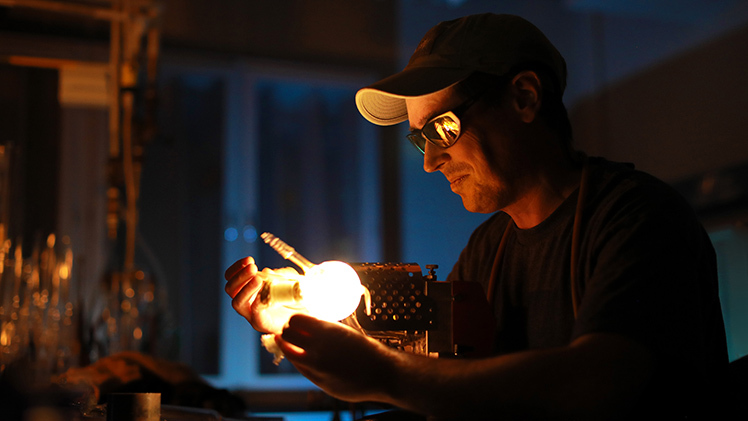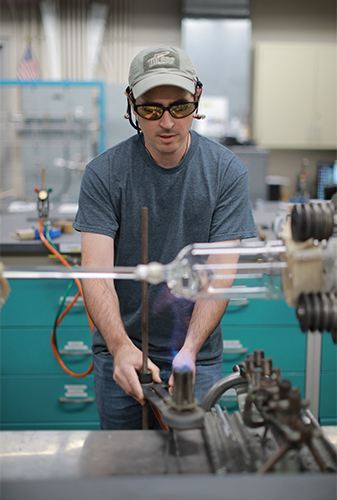In a small workshop tucked near the back of Bowman-Oddy Laboratories, Eamon King spends his days putting 3,000-degree flames to glass.
Glassblowing is a 2,000-year-old craft, the basic principles of which haven’t changed much since the Roman Empire. And yet as The University of Toledo’s scientific glassblower, King’s precise creations help to enable some of the most cutting-edge science being done at UToledo.

Eamon King’s position is housed within the Department of Chemistry and Biochemistry, with his work supporting the department’s research and educational missions. His services, however, are available to anyone across the University.
“There are portions of our research, particularly in synthetic chemistry, that wouldn’t be possible without what Eamon is able to do,” said Dr. Jon Kirchhoff, Distinguished University Professor and chair of the Department of Chemistry and Biochemistry. “It is a highly skilled craft, if not an artistry.”
King’s workspace looks more like a machine shop than an art studio. There are ovens and torches, but there’s also a drill press, calipers and shears, saws and a large lathe.
Job orders with hand-drawn diagrams cover the workbenches.
“It’s split about 50-50 between blank slate creations and repairs,” King said. “I get everything from simple fixes like a broken neck on a flask to requests for really specific things that either aren’t available or would cost a fortune to buy off the shelf.”
A specialized vacuum manifold, which allows researchers to perform reactions in the absence of reactive oxygen, for example, can easily cost $1,200 to $1,500 more from an online retailer. King can create the same apparatus for a couple hundred bucks — and eliminate the wait and damage risks associated with shipping.
He also can salvage costly broken glasswork. For example, King recently got a request to fix a large glass condenser that would cost more than $2,000 to replace. Repair cost? About 30 bucks.
“Having someone in-house who can create the same thing from the parts, it’s a huge cost saving,” Kirchhoff said. “It allows us the ability to perform unique experiments and it stretches our research dollars. When things break or get nicked up, it can be fixed instead of buying a new one.”
King’s position is housed within the Department of Chemistry and Biochemistry, with his work supporting the department’s research and educational missions. His services, however, are available to anyone across the University.
The rarity of King’s expertise also sends other universities and local industries calling on his expertise. He’s done work for the University of Cincinnati, Eastern Michigan University, Bowling Green State University and Stonybrook University.

Eamon King in his small workshop tucked near the back of Bowman-Oddy Laboratories.
Scientific glassblowers were once common at large universities but as glassblowers have retired, relatively few universities have kept their glass shops. Part of the reason is there’s not a large roster of people available to step in.
The American Scientific Glassblowers Society claims a membership of 650. King guesses there are about 1,000 people nationwide who specialize in scientific glassblowing. The vast majority of those work for industry.
King’s entry to scientific glassblowing came out of a lifelong love of working with glass.
“It’s definitely one of the most captivating materials you can work with because it’s always changing. You can’t focus on anything else when you’re working with glass,” he said. “You’ve really gotta give all your attention to the glass if you want to be successful and working with something molten is just hypnotic.”
King snagged a job at a glass studio right out of high school and, after earning an art degree at UToledo, spent more than a decade at the Toledo Museum of Art’s Glass Pavilion.
He ultimately returned to UToledo to earn a master’s degree and learn scientific glassblowing under master scientific glassblower Steve Moder, who was preparing to retire.
Through his education and a post-graduation apprenticeship, King learned to translate what he already knew about blowing glass for art into blowing glass for science.
“The biggest difficultly transitioning from art to science is learning how to adapt to doing things more like a machinist than an artist,” King said. “With artwork you’re all over the board. You’re not thinking about the end goal of a product. With the researchers, if they want something 15 millimeters, you need to make it 15 millimeters. You have to be within precise tolerances.”
Moder retired in 2020. King was hired as the University’s scientific glass blower in 2021 when the position was reinstated following temporary COVID-related cuts.
“He’s really talented and he picked it up very quickly,” Kirchhoff said. “We’ve been fortunate to keep him on here as a valuable resource for the University.”
King still does art glass as a hobby, but he’s developed a strong appreciation for the exacting work he completes to help advance science.
“What I’m making might just help with one step in a process, but it does feel good to know you’re helping a researcher figure something out that otherwise we might not know,” he said. “You’re doing something meaningful. It’s rewarding.”